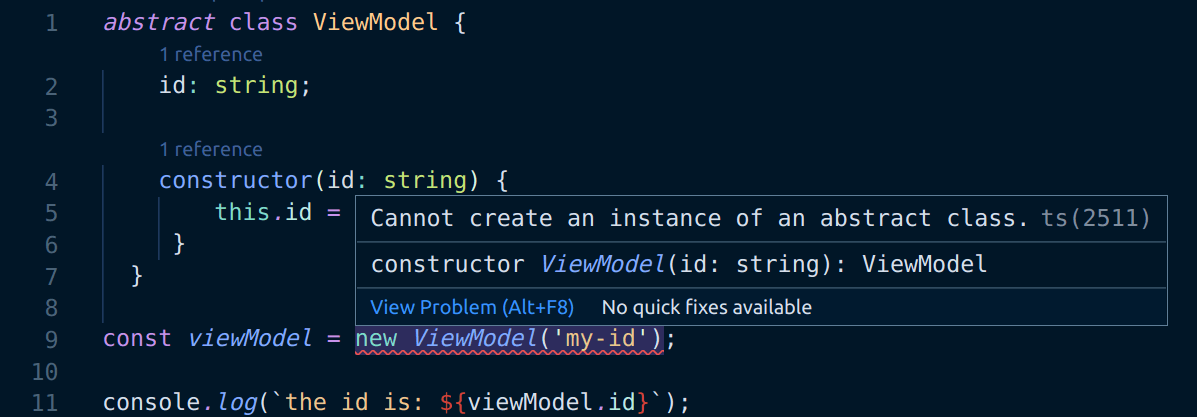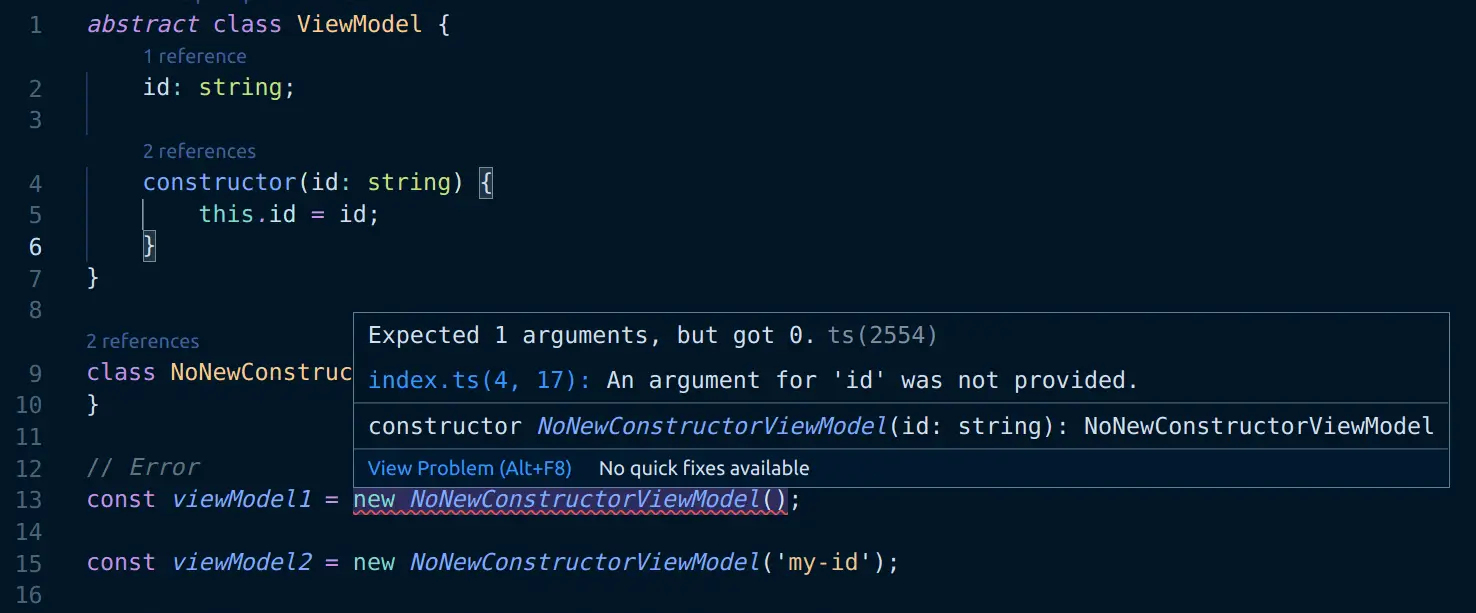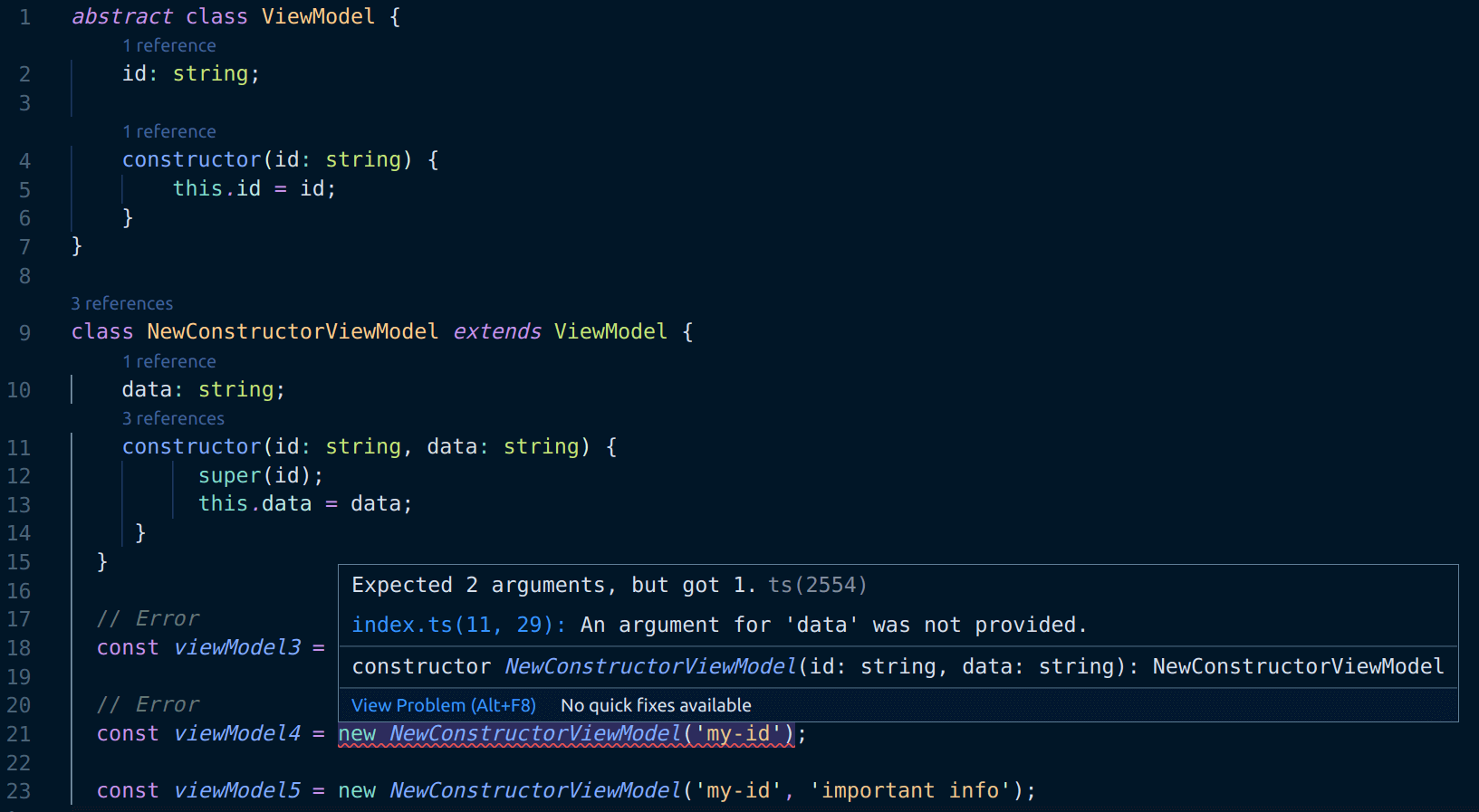TypeScript, abstract classes, and constructors
TypeScript has the ability to define classes as abstract. This means they cannot be instantiated directly, only non-abstract subclasses can be. Let's take a look at what this means when it comes to constructor usage.
Making a scratchpad
In order that we can dig into this, let's create ourselves a scratchpad project to work with. We're going to create a node project and install TypeScript as a dependency.
mkdir ts-abstract-constructors
cd ts-abstract-constructors
npm init --yes
npm install typescript @types/node --save-dev
We now have a package.json file set up. We need to initialise a TypeScript project as well:
npx tsc --init
This will give us a tsconfig.json file that will drive configuration of TypeScript. By default TypeScript transpiles to an older version of JavaScript that predates classes. So we'll update the config to target a newer version of the language that does include them:
"target": "es2020",
"lib": ["es2020"],
Let's create ourselves a TypeScript file called index.ts. The name is not significant; we just need a file to develop in.
Finally we'll add a script to our package.json that compiles our TypeScript to JavaScript, and then runs the JS with node:
"start": "tsc --project \".\" && node index.js"
Making an abstract class
Now we're ready. Let's add an abstract class with a constructor to our index.ts file:
abstract class ViewModel {
id: string;
constructor(id: string) {
this.id = id;
}
}
Consider the ViewModel class above. Let's say we're building some kind of CRUD app, we'll have different views. Each of those views will have a corresponding viewmodel which is a subclass of the ViewModel abstract class. The ViewModel class has a mandatory id parameter in the constructor. This is to ensure that every viewmodel has an id value. If this were a real app, id would likely be the value with which an entity was looked up in some kind of database.
Importantly, all subclasses of ViewModel should either:
-
not implement a constructor at all, leaving the base class constructor to become the default constructor of the subclass or
-
implement their own constructor which invokes the
ViewModelbase class constructor.
Taking our abstract class for a spin
Now we have it, let's see what we can do with our abstract class. First of all, can we instantiate our abstract class? We shouldn't be able to do this:
const viewModel = new ViewModel('my-id');
console.log(`the id is: ${viewModel.id}`);
And sure enough, running npm start results in the following error (which is also being reported by our editor; VS Code).
index.ts:9:19 - error TS2511: Cannot create an instance of an abstract class.
const viewModel = new ViewModel('my-id');

Tremendous. However, it's worth remembering that abstract is a TypeScript concept. When we compile our TS, although it's throwing a compilation error, it still transpiles an index.js file that looks like this:
'use strict';
class ViewModel {
constructor(id) {
this.id = id;
}
}
const viewModel = new ViewModel('my-id');
console.log(`the id is: ${viewModel.id}`);
As we can see, there's no mention of abstract; it's just a straightforward class. In fact, if we directly execute the file with node index.js we can see an output of:
the id is: my-id
So the transpiled code is valid JavaScript even if the source code isn't valid TypeScript. This all reminds us that abstract is a TypeScript construct.
Subclassing without a new constructor
Let's now create our first subclass of ViewModel and attempt to instantiate it:
class NoNewConstructorViewModel extends ViewModel {}
// error TS2554: Expected 1 arguments, but got 0.
const viewModel1 = new NoNewConstructorViewModel();
const viewModel2 = new NoNewConstructorViewModel('my-id');

As the TypeScript compiler tells us, the second of these instantiations is legitimate as it relies upon the constructor from the base class as we'd hope. The first is not as there is no parameterless constructor.
Subclassing with a new constructor
Having done that, let's try subclassing and implementing a new constructor which has two parameters (to differentiate from the constructor we're overriding):
class NewConstructorViewModel extends ViewModel {
data: string;
constructor(id: string, data: string) {
super(id);
this.data = data;
}
}
// error TS2554: Expected 2 arguments, but got 0.
const viewModel3 = new NewConstructorViewModel();
// error TS2554: Expected 2 arguments, but got 1.
const viewModel4 = new NewConstructorViewModel('my-id');
const viewModel5 = new NewConstructorViewModel('my-id', 'important info');

Again, only one of the attempted instantiations is legitimate. viewModel3 is not as there is no parameterless constructor. viewModel4 is not as we have overridden the base class constructor with our new one that has two parameters. Hence viewModel5 is our "Goldilocks" instantiation; it's just right!
It's also worth noting that we're calling super in the NewConstructorViewModel constructor. This invokes the constructor of the ViewModel base (or "super") class. TypeScript enforces that we pass the appropriate arguments (in our case a single string).
Wrapping it up
We've seen that TypeScript ensures correct usage of constructors when we have an abstract class. Importantly, all subclasses of abstract classes either:
-
do not implement a constructor at all, leaving the base class constructor (the abstract constructor) to become the default constructor of the subclass or
-
implement their own constructor which invokes the base (or "super") class constructor with the correct arguments.
